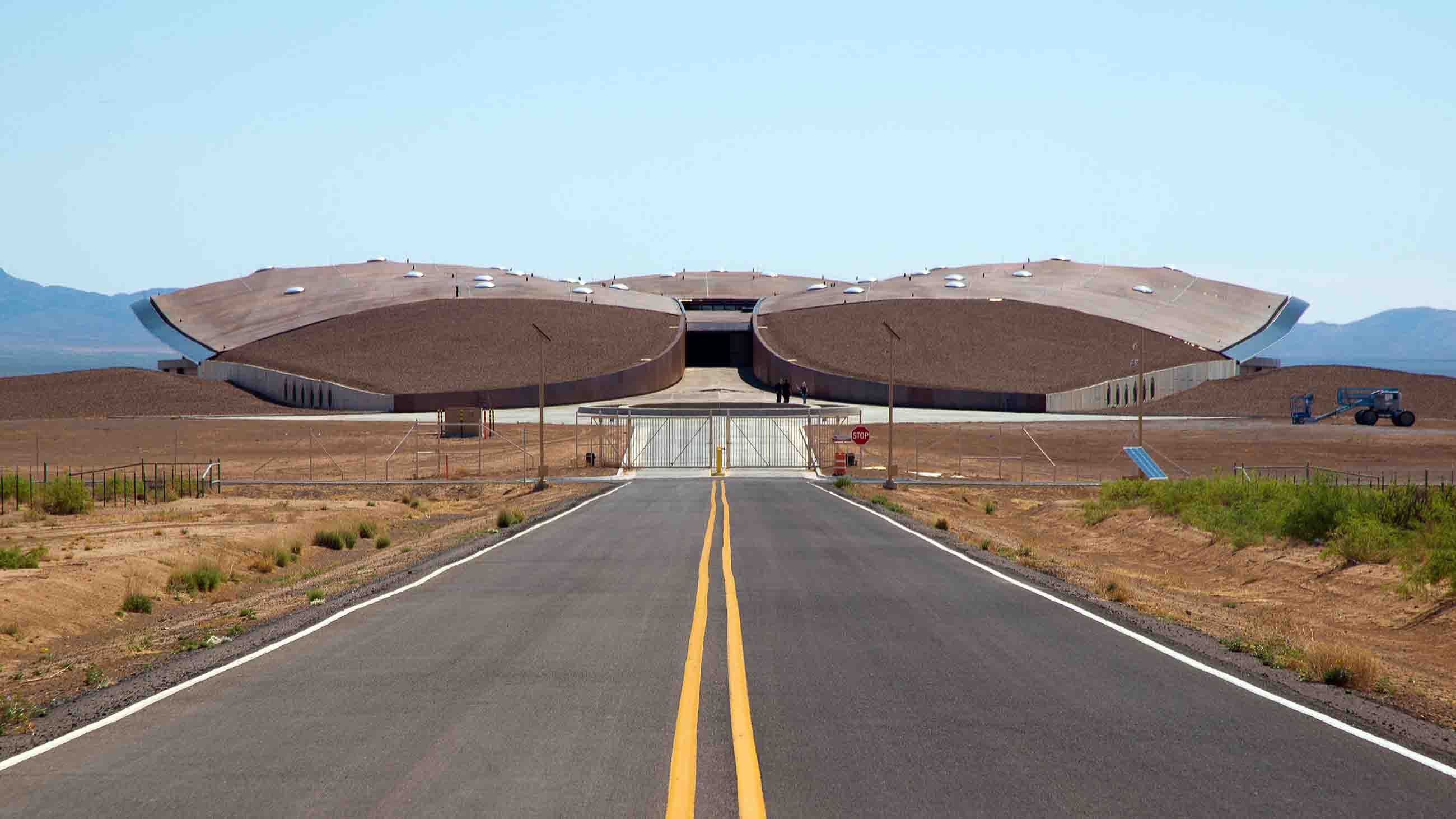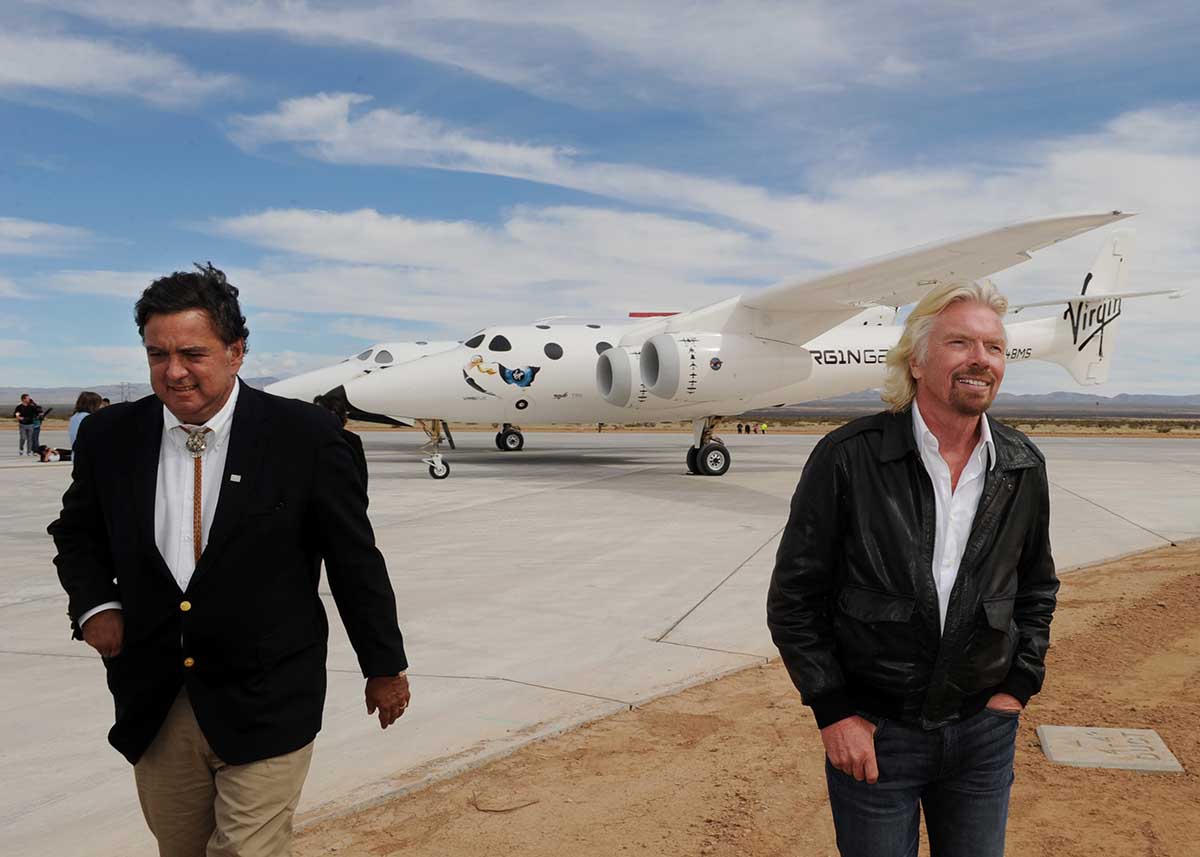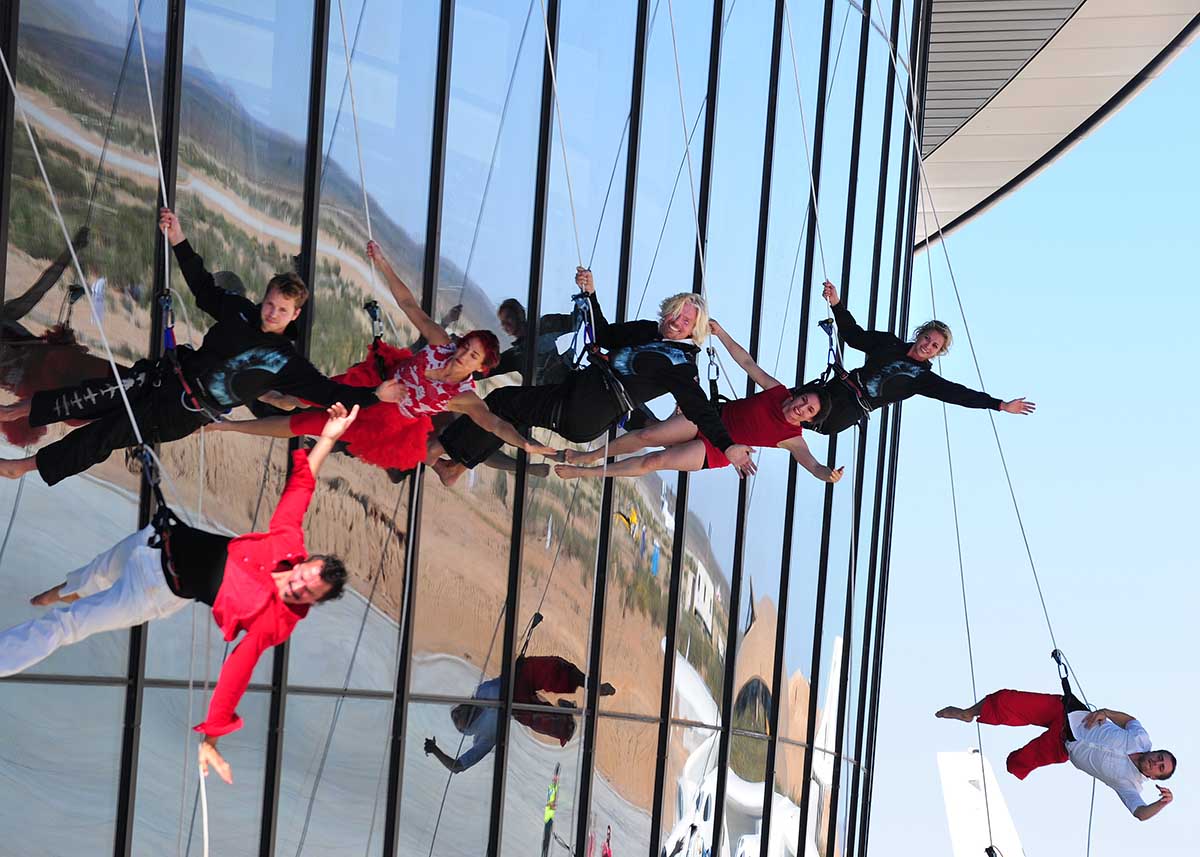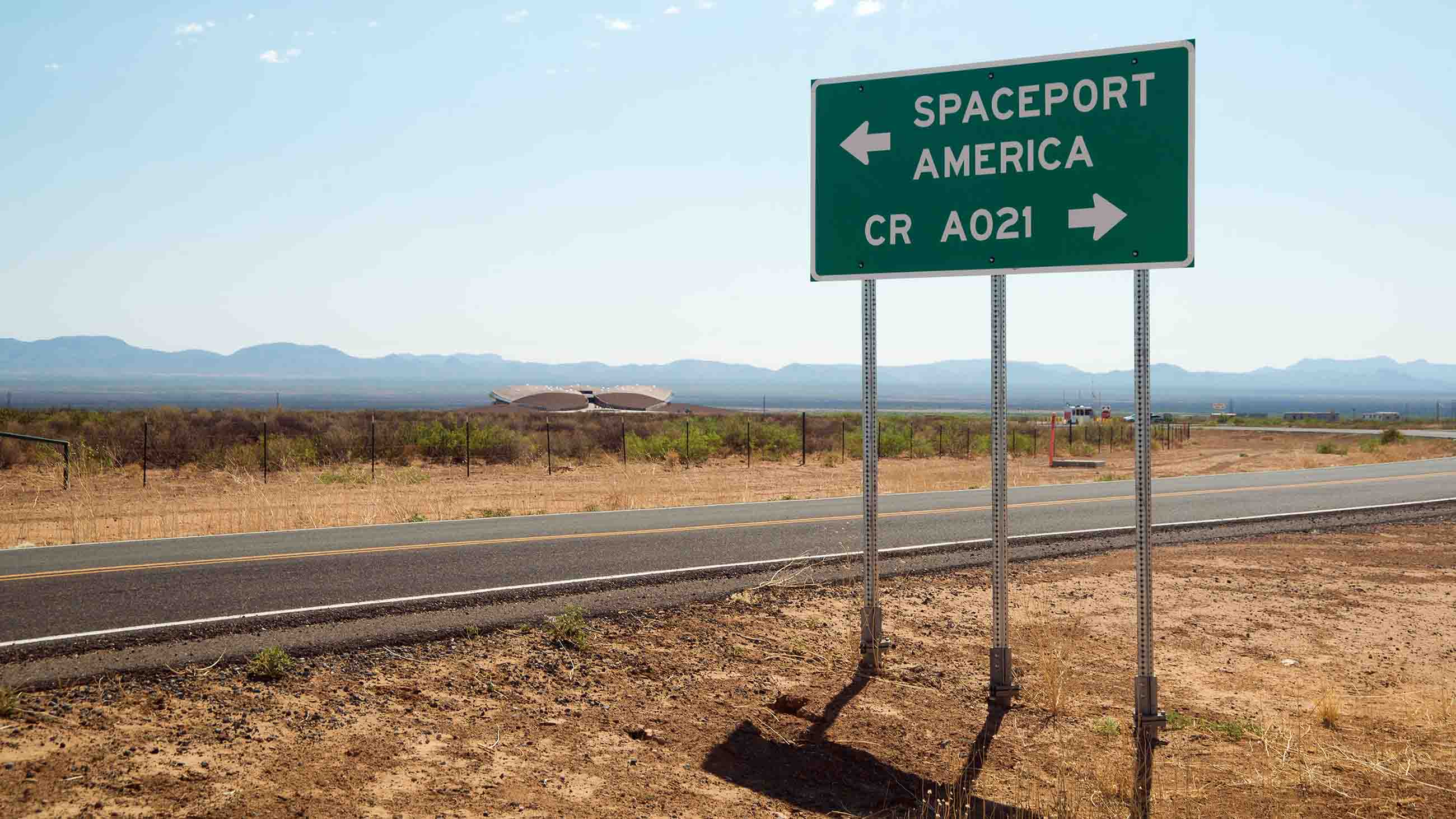Spaceport America: New Mexico’s Protracted Gamble on Spaceflight
The sun-bleached stretch of the New Mexico desert known as the Jornada del Muerto — the journey of the dead man — is an unlikely spot for Earth’s premier portal to another world. Yet this high desert outpost, with its empty horizon and indifferent cows grazing in the distance, is where you’ll find the two-mile long, three-and-a-half-foot deep concrete runway of Spaceport America, the first facility built as a hub for leisure travel to outer space.
Just over a decade ago, Spaceport America promised great things to the citizens of two of New Mexico’s poorest counties. So great, in fact, that residents voted in a tax hike to build and maintain it near the tiny town of Truth or Consequences (T or C). But the massive station has been an economic failure, tied to a stop-and-start commercial space industry that has failed to generate the tourism that residents were promised would help foot the bill. Perhaps more eerily, the spaceport itself has become a giant ghost town — a singular evocation of what happens when high hopes bump up against constraining realities.
In these expanses of empty New Mexico desert, people have long been looking to the stars. The state is home to the federally-sponsored Very Large Array, a radio astronomy observatory mapping outer space; the New Mexico Museum of Space History, east of the Trinity Site where the first atomic bomb was tested in 1945; and Roswell, the infamous town where an alleged UFO crashed in 1947.
But the desert is a tough place to build a revolution. Resources are scarce — not only water but also an educated work force, profitable employment, and infrastructure.
Spaceport America was supposed to change all that. In 2007, New Mexico’s then-Governor Bill Richardson promised that the project would yield 5,000 new jobs, and up to $1 billion in new revenue. In hopes of a revived economy, residents of Sierra and Doña Ana counties voted in a 0.25 percent gross receipts tax to build and maintain the spaceport, which sits on 18,000 acres of public trust land near the restricted airspace of White Sands Missile Range. The loftily named Spaceport America was largely built for preeminent tenant Virgin Galactic, the space tourism venture spearheaded by oddball business figure Richard Branson, whose fortunes rose with Virgin Records, which eventually turned into Virgin Group, a multinational power player with reach in many industries. Spaceport America — Virgin Galactic’s intended primary launch point — is situated between T or C (population at last count: 6,023) and Las Cruces, the state’s second largest city.
Penny and Joe McClarin have made their home in Las Cruces for 35 years, carving out a happy middle-class life near the foothills of the Organ Mountains. They voted in 2007 to fund the spaceport.
“We were excited when they brought it up and suggested a tax,” Joe said. But for all their high hopes, they admit they have seen little change in Las Cruces and the outlying area in the 11 years since, and the spaceport has largely fallen out of public discourse. The county has other problems. “The roads are terrible here,” Joe told me. “The schools are some of the lowest ranking in the whole country.” Penny added that infrastructure, particularly in the county’s more far flung areas, is an issue, with many remote areas still lacking access to internet. “The way it is right now,” Joe concluded, the spaceport is “just a big money pit.” By early 2018, New Mexicans had already invested more than $200 million in the spaceport, and in March, Governor Susana Martinez approved a budget that included another $10 million.
In February, I joined a small tour group of about a dozen people — each of us shelling out $50 — to get a more intimate view of Spaceport America. We took a passenger van about 45 minutes from T or C to a remote basin 20 miles southeast. As we crossed the massive Elephant Butte Dam and the trickling Cuchillo Negro Creek, we expected we would end up at a thriving technological hub. But when we emerged from the van and peered into the sloping glass window of the Virgin Galactic headquarters, we saw no evidence of activity there, or any presence of the 32 employees who work for Virgin Galactic at their Las Cruces offices. A few potted plants sat marooned in the narrow front rooms overlooking the runway, flecks of masking tape still clinging to the carpet. Could this possibly be the point of origin for the new dawn of space travel?
The tour, which runs every weekend in partnership with Final Frontier Tours, is spearheaded by Curtis Rosemond, who was our guide that day. It is one of several ways the spaceport has diversified its streams of revenue; another is hosting private research companies like EXOS and UP aerospace firms (though in terms of launches, their work doesn’t add up to much — there were a little more than a dozen in 2017, which was the busiest year on record). As our group, mostly in the over-50 age bracket, lingered by the Virgin Galactic headquarters, Curtis told us how, in October 2011, a jubilant Richard Branson officially opened the office for business by rappelling down the building’s glass wall while hoisting a bottle of champagne. But the celebration was not just weird; it was also a bit premature.
Three years after Branson’s stunt, in October 2014, the company’s test run of its flagship vehicle, SpaceShipTwo, ended tragically with the death of the craft’s co-pilot, Michael Alsbury. A nine-month investigation revealed that the cause of the crash was both human error and insufficient safety protocol. Since that time, progress on Virgin Galactic’s work at Spaceport America has been glacial in pace.



The rise and fall of technological innovation in this part of the country has happened before. In 2000, Eclipse Aviation, a private jet company that originated in Arizona, moved to New Mexico when the state and the city of Albuquerque offered incentives to relocate. It looked like the private aviation industry was set to boom — but in 2009, Eclipse Aviation declared bankruptcy. The whole enterprise is now considered a massive financial failure and, according to some, a possible harbinger of what might happen with Spaceport America.
For a “poor state with a poor track record of picking winners and losers,” Spaceport America was a huge gamble for many reasons, said Paul Gessing, president of the Rio Grande Foundation, a public policy research organization headquartered in Albuquerque. “We don’t know what the future of the commercial space industry is.” Gessing went on to question how deep this market is, stating “The reliance on somewhat unproven technology is critical.”
“There are just so many unknowns,” he added.
Among the unknowns, Gessing said, is psychology — the human creation of collective optimism. Hope is “a big part of the spaceport,” he said, especially in an economically challenged area like Las Cruces, where 24.4 percent of the population lives in poverty. Without the spaceport, predictions for job growth and economic development in the area, according to experts at the University of Texas El Paso’s Border Region Modeling Project, are bleak. The spaceport, Gessing said, “is a total Hail Mary.”
Commercial space flight will undoubtedly succeed someday. With NASA’s shuttle program eliminated and an increasing reliance on private companies to service the space program, there is plenty of room for commercial ventures to fill the gap and snatch up business, driving the industry forward. A Bank of America Merrill Lynch study in 2017 predicted that the space industry will be worth at least $2.7 trillion in 30 years. While predictions from Morgan Stanley came out at a lower $1.1 trillion by 2040, the Federal Aviation Administration nonetheless projects initial growth in the commercial sector within the next decade. And other states have been getting on the bandwagon with arguably more success than New Mexico has had. While Spaceport America has languished, California, Virginia, Florida, Oklahoma, Texas, and Alaska all have continued to build spaceport facilities licensed to host commercial space flights. Some of these are also publicly funded, but others will be owned and operated by the businesses themselves. The site currently under construction outside Brownsville, Texas, for instance, is being built privately by SpaceX, the brainchild of technology innovator Elon Musk.
For the time being, most of the major players in the industry use multiple spaceports. SpaceX has a small contract at Spaceport America, while Virgin Galactic primarily does its flight testing at the Mojave Air & Spaceport in Mojave, California.
Despite these pockets of activity, though, things at Spaceport America have generally been grim. In 2015, New Mexico State Senator George K. Muñoz proposed legislation to sell the spaceport, directing the Spaceport Authority to develop a marketing plan and maintain the facility until a sale was finalized. The bill ultimately failed in the state legislature.
In recent years, the spaceport has been the site of production for sci-fi films like “After Earth” and “The Space Between Us,” and was even the set for a few Nike commercials. Despite these creative uses, the facility hasn’t quite made its existence worthwhile. As Gessing pointed out, another nationwide recession, or a dip in the price of oil (an industry New Mexico relies heavily upon), could precipitate “a reckoning” for the spaceport.
Nonetheless, Richard Branson is still enthusiastic about Spaceport America. He says he will be on his company’s inaugural flight from the spaceport by December, and that regular Virgin Galactic commercial flights will begin soon thereafter. The company has indicated they are “on benchmark” to meet this timeline, and have sold 500 tickets at $250,000 each to the global upper crust, including celebrities like Leonardo DiCaprio, Tom Hanks, and Princess Beatrice of York, the granddaughter of Queen Elizabeth. These brief trips will rocket ticketholders to 62 miles above Earth to suborbital space, where they will experience iconic views of the planet and a few moments of weightlessness.
Just what these developments might mean for Spaceport America in the long term is difficult to say. In a recent interview with Air & Space Magazine, Joe Pappalardo, the author of the book “Spaceport Earth: The Reinvention of Spaceflight,” called Branson “a showman, with a tendency to overpromise” — though he also suggested that the New Mexico facility was “finally on the verge of fulfilling some of its promise.”
Still, in 2005, Virgin’s plans indicated that flights would begin in 2008. Later, in September of 2011, Branson estimated that regular launches would start in about 12 months. Then, in 2014, he said the premiere launch would be in the first months of 2015. At this point, it is hard for critics to believe that Virgin Galactic will take flight in New Mexico before 2018 is over, given that such deadlines have been set — and passed — many times before.
Local news reports have begun asking when — if ever — Spaceport America will deliver on the promises of jobs and economic dividends.
There have been auspicious recent developments in the industry at large, however. The successful launch in February of Falcon Heavy, designed by Elon Musk’s venture SpaceX, is encouraging for the entire industry, indicating that commercially viable technology might be near. In Mojave, California, rocket-powered tests for Virgin Galactic’s redesigned spacecraft, now called VSS Unity, have begun. The craft completed its first powered flight test run in April, reportedly reaching a speed of Mach 1.6, prompting Branson to tweet, “space feels tantalizingly close now.”
The company promises that soon more staff will be moved to New Mexico and the Spaceport America facility, where further testing will take place in anticipation of bona fide commercial launches later this year. To date, Virgin Galactic has spent more than $10 million in New Mexico, enlisting local businesses for everything from catering to construction, largely from companies based in and around Las Cruces. Given that more states are moving to establish their own spaceports, and investors like Saudi Arabia’s Public Investment Fund are pumping $1 billion into businesses like Virgin Galactic, it does seem like the industry is finally gaining purchase, though hopes that the effects of success will trickle down to New Mexicans may be wilting.
A combination of the sunk cost fallacy and faith has sustained Spaceport America so far. But the novelty is wearing off, and New Mexico is losing its competitive edge as other states build spaceport facilities. For many residents, what drives the project forward is a simple hope that the state’s investments will finally create returns.
In the crowded Truth or Consequences Brewing Company on a Saturday night, a 30-something Las Cruces resident tipped back the last of his beer as a country band began its set on the small wooden stage. “Of course I’m frustrated,” said the resident, who asked me not to use his name. “But I’m a New Mexican; I want to see it succeed.” The McClarins had said much the same thing earlier in the day as we sat around their kitchen table. “I want to see it happen, I really do,” Penny had told me. Even Paul Gessing of the Rio Grande Foundation claimed he would like to be proven wrong on this count.
Before meeting the McClarins, I had asked Curtis Rosemond, the Final Frontier tour guide, if he had seen T or C become more bustling and successful thanks to the spaceport. “It will be,” he answered confidently, sitting beneath a banner hung from the ceiling of the visitor center printed with feel-good phrases like “opportunity,” “commerce,” and “adventure.” The question now is whether the locals will buy into such platitudes, and how long it will take before their patience wears thin.
Maggie Grimason is a New Mexico-based writer and the the arts & literature editor for The Weekly Alibi, Albuquerque’s free alternative weekly.











Comments are automatically closed one year after article publication. Archived comments are below.
Hi, I am from Texas and I have seen some dumb things and I believe that pigs will learn to fly before any one including Sir Branson get their fat rear into space on a epoxy flying contraption. Branson can sell Ice Cream Machines to Eskom’s. The only way out of this debacle is develop your own Burning Man event much like the burning of the evil spirit that was held in Taos on an annual event. You are close to El Paso , so organize around the core Military and College populations. Start small but advertise BIG and just make it a fun social event for every one in the New Mexico area. Have a grand prize , have pretty Indian girls, free tamales , beer and invite the Governor. If you need any more ideas just call “007 Wingman”
You will probably find that no matter who pays for it and runs, Richard Branson will make a big play of pretending that the whole thing is run by, and belongs to, Virgin.
Patricia Riley claims to have five (count ’em, FIVE) college degrees, including a masters degree, and three vocations. Hmm. Given the poor grammar, spelling, and punctuation in her screed, I’d hate to see what colleges she attended. Perhaps her point is well-taken. Perhaps New Mexico’s schools ARE turning out students poorly prepared for the real world.
So you think I can’t spell…I was reading what I wrote… not one misspelled word… and I do have five degrees…one associate degree.. double bachelor’s degree …one master’s degree…one minor in foreign language and a cosmetology license…. I’m not you’re typical New mexican…I earned everything I worked hard for and no one can take my education skills or life experiences…so gene you’re a fucking asshole…. let’s see did I spell everything ok for you
One of the biggest problems with this spaceport is that it is nowhere near the ocean. Launches out of Cape Canaveral in Florida go over the Atlantic. Launches from Vandenberg in California go South over the Pacific on a polar orbit. Rocket companies don’t like to launch over large chunks of land because if their rocket fails the parts can fall on buildings and houses. I feel that Virgin will fly from Spaceport America, but they will probably also fly from Mojave, breaking up the launches. I don’t know who else will be launching from Spaceport America, but even when Virgin decides to create an orbital craft they will probably choose to launch from one of the coasts.
In many third-world states, tourism is a major industry. So it fits New Mexico’s reflexive responses that it would support space travel as a tourist industry. How intelligent is it, however, to spend millions, possibly billions, on tourism when most tourism involves nearly cost-free infrastructure? It is also typical–and a clear sign of desperation–for a third-world state to squander resources on gambles which private corporations refuse to fund because the risk is too great. Corporations are still telling the state that SpacePort is a boondoggle: they are going elsewhere. And tourists will launch from these developing “elsewheres.” New Mexico should save its money for better purposes, and these do not include tourism.
Great article, but there are three more aspects of Spaceport America that need to be addressed.
Why is all of the funding for building and operating the Spaceport coming from state and local governments? There is no private investment in the facility. Wouldn’t it make more sense to get some private, at-risk money into the deal, to maybe start making sense out of it?
Why is the operation, planning, maintenance, expansion all done by the state? The State of New Mexico has not proven itself to be competent at anything, yet – how do the powers that be believe they can be the best at owning and operating a Spaceport? In line with the first part, why not sell the whole deal and let it be run by private ventures who know what they are doing, and have the capital to do what’s needed to make it successful, if that is possible?
The current Spaceport director has estimated it will take $7 Billion to upgrade the Spaceport to make it competitive with others being built around the country and the world. Where will that money come from, and is it worth the investment and gamble – and WHO is the competent activity to make that evaluation?
And on we go –
I am a fan of space technology…unmanned.
Manned space flight is and will continue to be an expensive sideshow for the next century. No, there are not going to be commercially viable manned space flights. Any money made in space will be what it is now…satelites. Even that area has limited potential with the launch of multiple units that contain ever increasing capacity. China, India, Ausa, Europe, Russia and others will compete for a limited market.
Waiting….we new Mexicans are sick and tired of waiting for WHAT?…the majority of the people here are poor and uneducated because our schools have failed literally a big fat F and D- grade for 7 years running…there is no economic growth and development but plenty of crime drugs and corruption at the highest and lowest levels of government and academia…it’s all CRAP and the ones running for public office in mid term election are the same old criminal cartel spewing the same old story about economic growth and development and how theylove the people…it’s all CRAP on both sides of the political aisle…the familia and their gangs run the show always have and probably always will…the progressive liberal card carrying communist fascist Marxists have complete control of the failed state of Nuevo Mexico otherwise known as a cacahole…and i should know I’m a native from Las cruces and hold five worthless college degrees one being a masters degree and have three vocations…i still have no real good job and the pay is slave wages…sad very very sad…I guess if I was a criminal drug dealer i would bank but I’m not…
I think you ought to look up the definition of the word media hype. Have you ever taken a drive there from Las Cruces or El Paso. That will sober you up. I drove there on that horrible dirt road, hit a trench and ruined my van, a Dodge heavy duty. I take people should do some research that is significant to the topic. I wrote this once
Good article about history of Spaceport. Part of the reason I moved to this area was because of Spaceport, a progressive move reflecting on our area.
It is time to get the ball rolling and start utilizing this great facility.
I’m hoping that Branson is not talking thru his ears and really has something planned for the later part of 2018.
This is an insightful and educational piece that I hope prompts dialogue to yield the promise of economic growth to this region